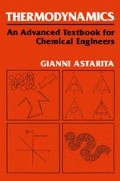Abstract
Relaxation phenomena are of particular importance in the mechanics of polymeric systems, and the corresponding thermodynamic theory presents very significant mathematical complexities since, in addition to the need for functional analysis, continuum mechanics introduces the additional complexity related to the fact that an appropriate three-dimensional description requires a basis in tensor analysis. The purpose of this chapter is not that of presenting the complete thermodynamic theory of relaxation, but only the essential aspects of it, and as much of the mathematical complexities as possible are left out of the picture. There is no way of avoiding functional analysis, but tensors can be avoided by restricting attention to systems described only by scalars. Of course, the systems considered below are so simple that, in actual fact, one would describe them with a theory based on internal state variables; however, they do exhibit relaxation phenomena, and the essential features of the thermodynamic theory of relaxation can hopefully be grasped by consideration of such simple systems.
I might proceed to apply the theory to the phenomena of combustion, the heat of which consists in the living force occasioned by the powerful attraction through space of the combustible for the oxygen, and to a variety of other thermochemical phenomena; but you will, doubtless, be able to pursue the subject further at your leisure. I do assure you that the principles which I have very imperfectly advocated this evening, may be applied very extensively in elucidating many of the abstruse as well as the simple points of science; and that patient inquiry on these grounds can hardly fail to be amply rewarded.
J. P. Joule, 1847
Access this chapter
Tax calculation will be finalised at checkout
Purchases are for personal use only
Preview
Unable to display preview. Download preview PDF.
Literature
The literature on the thermodynamics of systems endowed with finite relaxation times is generally difficult to read, because of its mathematical complexity, which is related to the fact that such systems generally exhibit internal stresses that are very significantly different from a simple isotropic pressure. The basic references are B. D. Coleman and W. Noll, Arch. Ratl. Mech. Anal. 13, 167 (1963), and
B. D. Coleman, Arch. Ratl. Mech. Anal. 17, 1 (1964).
A somewhat simplified introduction to the subject is given in G. Astarita, An Introduction to Non-Linear Continuum Thermodynamics, SpA Ed. di Chimica, Milan (1975).
In this chapter, the subject has been approached by considering phenomena where the finite relaxation time is related to a reasonably well understood kinetic process which is taking place. The relationship between a phenomenological, memory-type description and one which chooses internal state variables is discussed in G. Astarita and G. C. Sarti, Polym. Eng. Sci. 16, 490 (1976).
G. C. Sarti and G. Astarita, Trans. Soc. Rheol. 19, 215 (1975).
Relaxation phenomena are of particular importance in the case of polymeric materials. An ample literature where the statistical mechanics of polymeric media is developed, and the thermodynamic consequences thereof are analyzed, is available. The following references are of importance: M. Doi and S. F. Edwards, “The Theory of Polymer Dynamics”, Clarendon Press, Oxford (1986)
R. B. Bird et al., Dynamics of Polymeric Liquids, Wiley, New York (1977); and
G. Marrucci, Advances in Transport Processes, Vol. 5, Wiley, New York (1988).
When speaking of systems endowed with finite relaxation times, the question of what is meant by entropy outside of an equilibrium (or possibly “quasi-static”) situation is bound to emerge. First of all, the idea that one can write a “balance” equation for entropy (though of course including the requirement of a nonnegative generation term) is by now almost 100 years old. See J. Jaumann, Wiener Akad. Sitz. 120, 385 (1911); Wiener Akad. Wiss. Denkshr. 95, 461 (1918); and
K. Lohr, Wiener Akad. Wiss. Denkshr. 93, 339 (1917); 99, 59 (1924). On these papers
K. Denbigh, The Thermodynamics of the Steady State, Methuen, London (1951), remarks that: “Their discussion covers some five hundred pages of the German text and it is perhaps for this reason that their work has been somewhat overlooked.”.
Inclusion of a generation term of course implies not only that a “balance” equation for entropy can be written under nonequilibrium conditions, but also, and more fundamentally, that entropy has a meaning outside of equilibrium. The literature on the statistical mechanics of polymeric systems cited above is of help in visualizing such entropy as being related to the conformational statistics of the systems, which may be nonequilibrium.
The question of entropic elasticity is well known in the equilibrium theory of rubbers. Its extension to nonequilibrium situations of general polymeric materials is discussed in G. Astarita and G. C. Sarti, in: Theoretical Rheology (J. F. Hutton, J. R. A. Pearson, and K. Walters, eds.), Applied Science, Barking (1975).
Propagation of discontinuities in relaxational systems is discussed in B. D. Coleman et al., Wave Propagation in Dissipative Materials, Springer-Verlag, New York (1965).
The discussion in this chapter shows that, for all the systems considered, it is possible to move from one equilibrium state to another via a sufficiently slow transformation in order to make the energy dissipation as small as one wishes. While this supports the success of thermodynamic analyses which use some handwaving argument of the “quasistatic process” type, it does not guarantee that such arguments are bound to be invariably successful.
Author information
Authors and Affiliations
Rights and permissions
Copyright information
© 1989 Springer Science+Business Media New York
About this chapter
Cite this chapter
Astarita, G. (1989). Thermodynamics of Relaxation. In: Thermodynamics. Springer, Boston, MA. https://doi.org/10.1007/978-1-4899-0771-4_6
Download citation
DOI: https://doi.org/10.1007/978-1-4899-0771-4_6
Publisher Name: Springer, Boston, MA
Print ISBN: 978-1-4899-0773-8
Online ISBN: 978-1-4899-0771-4
eBook Packages: Springer Book Archive

